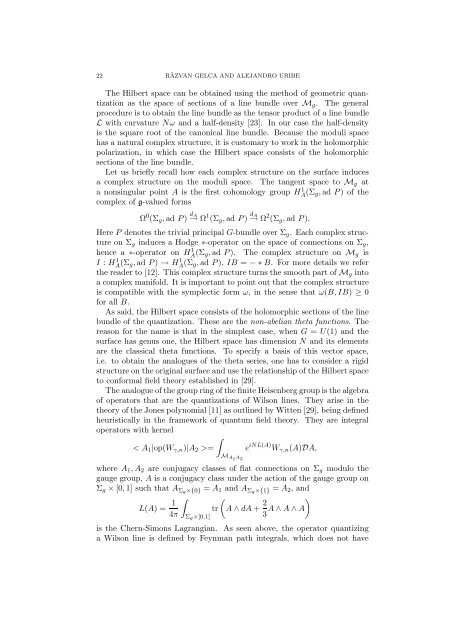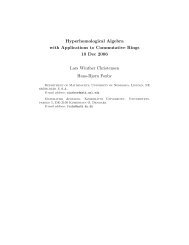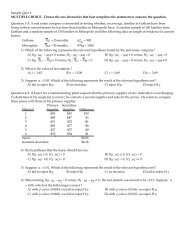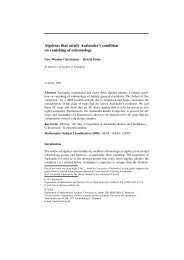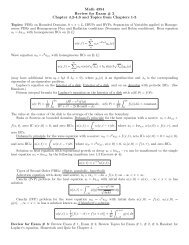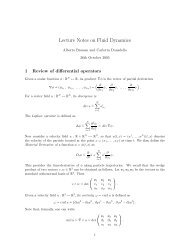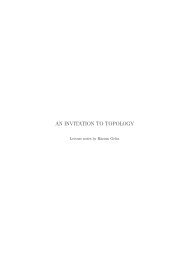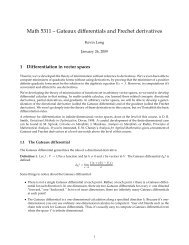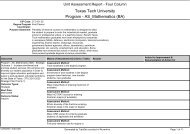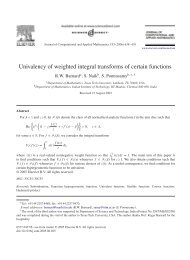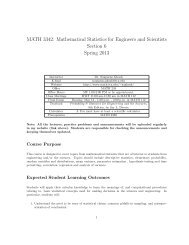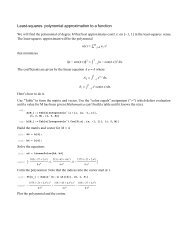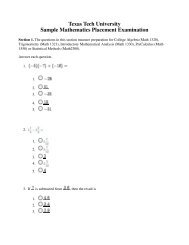QUANTUM MECHANICS AND NON-ABELIAN THETA FUNCTIONS ...
QUANTUM MECHANICS AND NON-ABELIAN THETA FUNCTIONS ...
QUANTUM MECHANICS AND NON-ABELIAN THETA FUNCTIONS ...
You also want an ePaper? Increase the reach of your titles
YUMPU automatically turns print PDFs into web optimized ePapers that Google loves.
22RĂZVAN GELCA <strong>AND</strong> ALEJ<strong>AND</strong>RO URIBEThe Hilbert space can be obtained using the method of geometric quantizationas the space of sections of a line bundle over M g . The generalprocedure is to obtain the line bundle as the tensor product of a line bundleL with curvature Nω and a half-density [23]. In our case the half-densityis the square root of the canonical line bundle. Because the moduli spacehas a natural complex structure, it is customary to work in the holomorphicpolarization, in which case the Hilbert space consists of the holomorphicsections of the line bundle.Let us briefly recall how each complex structure on the surface inducesa complex structure on the moduli space. The tangent space to M g ata nonsingular point A is the first cohomology group H 1 A (Σ g,ad P) of thecomplex of g-valued formsΩ 0 (Σ g ,ad P) dA → Ω 1 (Σ g ,ad P) dA → Ω 2 (Σ g ,ad P).Here P denotes the trivial principal G-bundle over Σ g . Each complex structureon Σ g induces a Hodge ∗-operator on the space of connections on Σ g ,hence a ∗-operator on HA 1(Σ g,ad P). The complex structure on M g isI : HA 1(Σ g,ad P) → HA 1(Σ g,ad P), IB = − ∗ B. For more details we referthe reader to [12]. This complex structure turns the smooth part of M g intoa complex manifold. It is important to point out that the complex structureis compatible with the symplectic form ω, in the sense that ω(B,IB) ≥ 0for all B.As said, the Hilbert space consists of the holomorphic sections of the linebundle of the quantization. These are the non-abelian theta functions. Thereason for the name is that in the simplest case, when G = U(1) and thesurface has genus one, the Hilbert space has dimension N and its elementsare the classical theta functions. To specify a basis of this vector space,i.e. to obtain the analogues of the theta series, one has to consider a rigidstructure on the original surface and use the relationship of the Hilbert spaceto conformal field theory established in [29].The analogue of the group ring of the finite Heisenberg group is the algebraof operators that are the quantizations of Wilson lines. They arise in thetheory of the Jones polynomial [11] as outlined by Witten [29], being definedheuristically in the framework of quantum field theory. They are integraloperators with kernel∫< A 1 |op(W γ,n )|A 2 >= e iNL(A) W γ,n (A)DA,M A1 A 2where A 1 ,A 2 are conjugacy classes of flat connections on Σ g modulo thegauge group, A is a conjugacy class under the action of the gauge group onΣ g × [0,1] such that A Σg×{0} = A 1 and A Σg×{1} = A 2 , andL(A) = 14π∫Σ g×[0,1]tr(A ∧ dA + 2 )3 A ∧ A ∧ Ais the Chern-Simons Lagrangian. As seen above, the operator quantizinga Wilson line is defined by Feynman path integrals, which does not have


